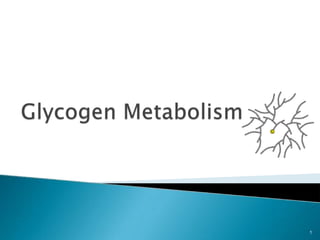
Glycogen Metabolism.pptx
- 1. 1
- 2. Glycogen is a readilymobilizedstorageformof glucose. It is a very large, branched polymer of glucose residues that can be broken down to yield glucose molecules when energy is needed. Most of the glucose residues in glycogen are linked by α-1,4-glycosidic bonds. Branches atabouteverytenthresiduea r ecreatedby α-1,6-glycosidic bonds. 2
- 4. Glycogen is present in the cytosol in the form of granules ranging indiameterfrom10to40 nm. It has a molecular mass of 107 Da and consists of polysaccharide chains, each containing about 13 glucose residues. The chains are either branched or unbranched and are arranged in 12 concentric layers. The branchedchains(eachhastwobranches) arefound intheinnerlayersand the unbranched chains in the outer layer. (G, Glycogenin, the primer molecule for glycogen synthesis.)
- 5. The highly branched structure of glycogen provides a large number of sites for glycogenolysis, permitting rapid release of glucose 1-phosphate for muscle activity. Glycogenin
- 6. It is stored mainly in livera n d muscle The liver content of glycogen is greater than that of muscle, Since the muscle mass of the body is considerably greater than that of the liver, about three-quartersoftotal bodyglycogenis in muscle
- 7. Percentageof TissueWeight TissueWeight BodyContent Liver glycogen 5.0 1.8 kg 90 g Muscle glycogen 0.7 35 kg 245 g Extracellular glucose 0.1 10 L 10 g
- 8. Glycogen serves as a bufferto maintain blood-glucose levels. Glucose is virtually the onlyfuelusedbyt h ebrain, except during prolonged starvation. The glucose from glycogen is readily mobilized andisthereforeagoodsourceof energyforsudden, strenuous activity. Unlike fatty acids, the released glucose can provideenergyintheabsenceofoxygenand can thus supply energy for anaerobic activity.
- 9. Glycogenesisisthesynthesisofglycogen from glucose. Glycogenesis mainly occurs in musclea n dliver. Muscle glycogen provides a readily available sourceofglucoseforglycolysis within the muscle itself. Liverglycogenfunctionstostoreand export glucosetomaintainbloodglucose betweenmeals.
- 11. oAlanine and lactate transported from muscle are used for glucose production in liver by gluconeogenesis. oGlucose is poured in blood to maintain homeostasis.
- 12. 1) Activationof Glucose 2) Initiation 3) Elongation 4) Glycogenbranching
- 13. Synthesis of glycogen from glucose i s carried out by the enzyme glycogen synthase. This enzyme utilizes UDP-glucose as one substrate and the non-reducing end of glycogen as another. UDP-glucose, the glucose donor in t h e biosynthesis of glycogen, is an activated form of glucose.
- 14. UDP-glucose is formed from glucose-1- phosphate: Spontaneous hydrolysis of the ~P bond in PPi (P~P) drives the overall reaction. Cleavage of PPi is the only energy cost for glycogen synthesis (one ~P bond per glucose residue).
- 15. As in glycolysis, glucose is phosphorylated to glucose 6- phosphate, catalyzed by hexokinasein muscle and glucokinasein liver. Glucose 6-phosphate is isomerized to glucose 1-phosphate by Phosphoglucomutase. Glucose 1-phosphate reacts with uridine triphosphate (UTP) to form the active nucleotide uridine diphosphate glucose(UDPGlc)and pyrophosphate. The reaction is catalyzed by UDPGlc pyro phosphorylase.
- 16. Glycogen synthase can add glucosyl residues only if the polysaccharide chain already contains more than four residues. Thus, glycogensynthesis requires aprimer. This priming function is carried out by glycogenin, A protein composed oftwo identical 37-kd subunits, each bearing an oligosaccharide of alpha-1,4-glucose units.
- 17. A glycosidicbond is formed between the anomeric C1 of the glucose moiety derived from UDP-glucose and the hydroxyl oxygen of a tyrosine side- chain of Glycogenin. UDP is released as a product. Each subunit of glycogenin catalyzes the addition of eight glucose units to its partner in the glycogenin dimer. At this point, glycogen synthase takes over to extend the glycogen molecule.
- 18. New glucosyl units are added to the nonreducing terminal residues of glycogen. The activated glucosyl unit of UDP glucose is transferred to the hydroxyl group at aC-4 terminus of glycogen to form an α-1,4-glycosidic linkage. In elongation, UDP is displaced by the terminal hydroxyl group of the growing glycogen molecule. This reaction is catalyzed by glycogensynthase,thek e yregulatory enzymeinglycogen synthesis.
- 19. Both synthesis &breakdown of glycogen are spontaneous. If both pathways were active simultaneously in a cell, there would be a "futile cycle"with cleavage of one~Pbondpercycle(in forming UDP-glucose).To prevent this both pathways are reciprocally regulated GlycogenSynthesis UTP glycogen(n)+glucose-1-P UDP + 2Pi glycogen(n+1) GlycogenPhosphorylase Pi
- 20. Glycogen synthase catalyzes only the synthesis of α-1,4 linkages. Another enzyme is required to form the α-1,6 linkages that make glycogen a branched polymer. Branching occurs after a number of glucosyl residues are joined in α-1,4 linkage by glycogen synthase. A branch is created by the breaking of an α-1,4 link and the formation of an α-1,6 link.
- 21. A block of residues, typically 7 in number,is transferred to a more interior site. The branchingenzymethat catalyzes this reaction is quite exacting. The block of 7 or so residues must include the nonreducing terminus and come from a chain at least 11 residues long. In addition, the new branch point must be a t least 4 residuesawayfromapreexistingone.
- 22. Branchingis importantbecauseitincreasesthesolubilityof glycogen. Furthermore, branching creates a large number of terminal residues, the sites ofactionofglycogenphosphorylaseandsynthase.Thus, branchingincreasesthe rateofglycogensynthesisanddegradation.